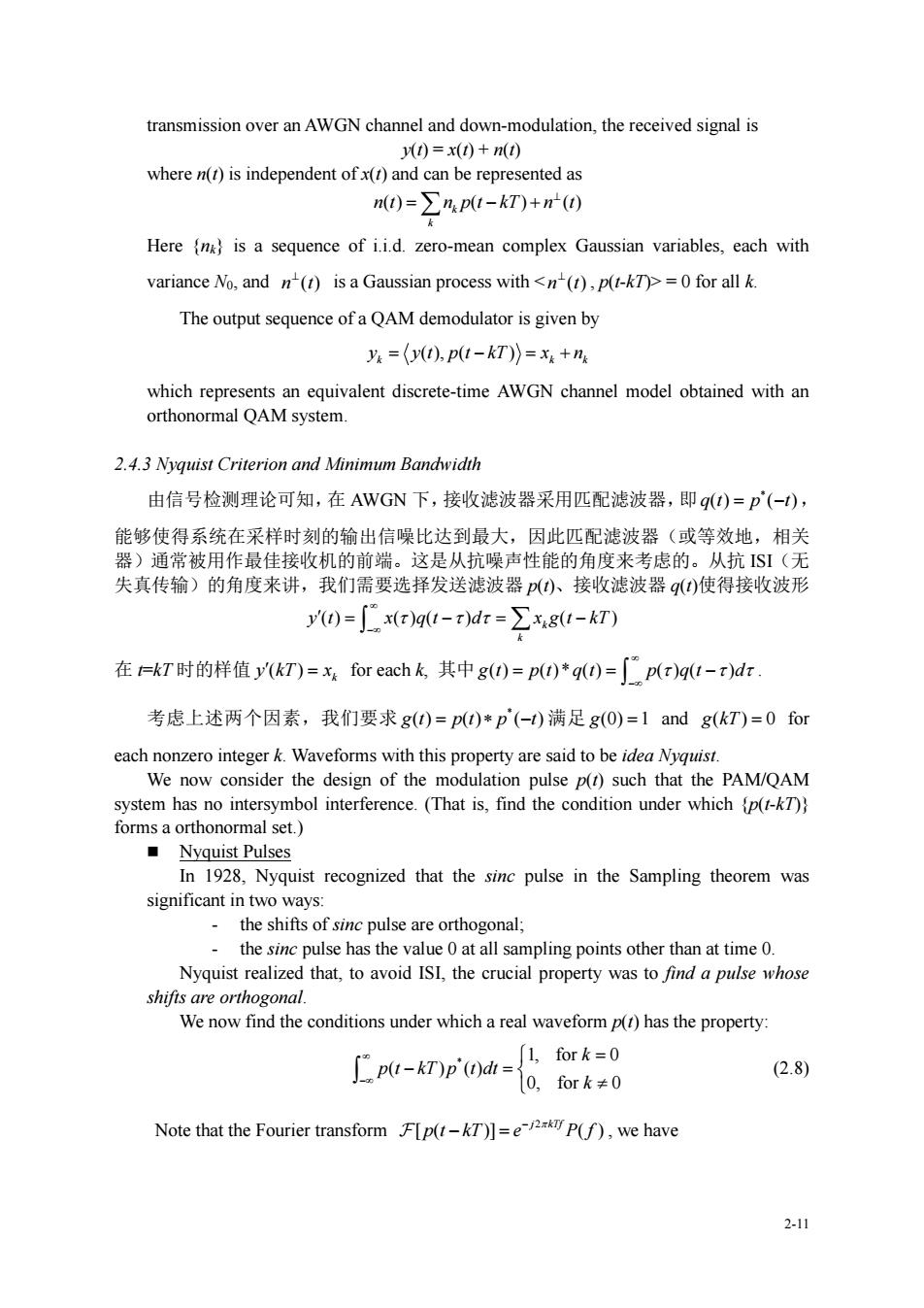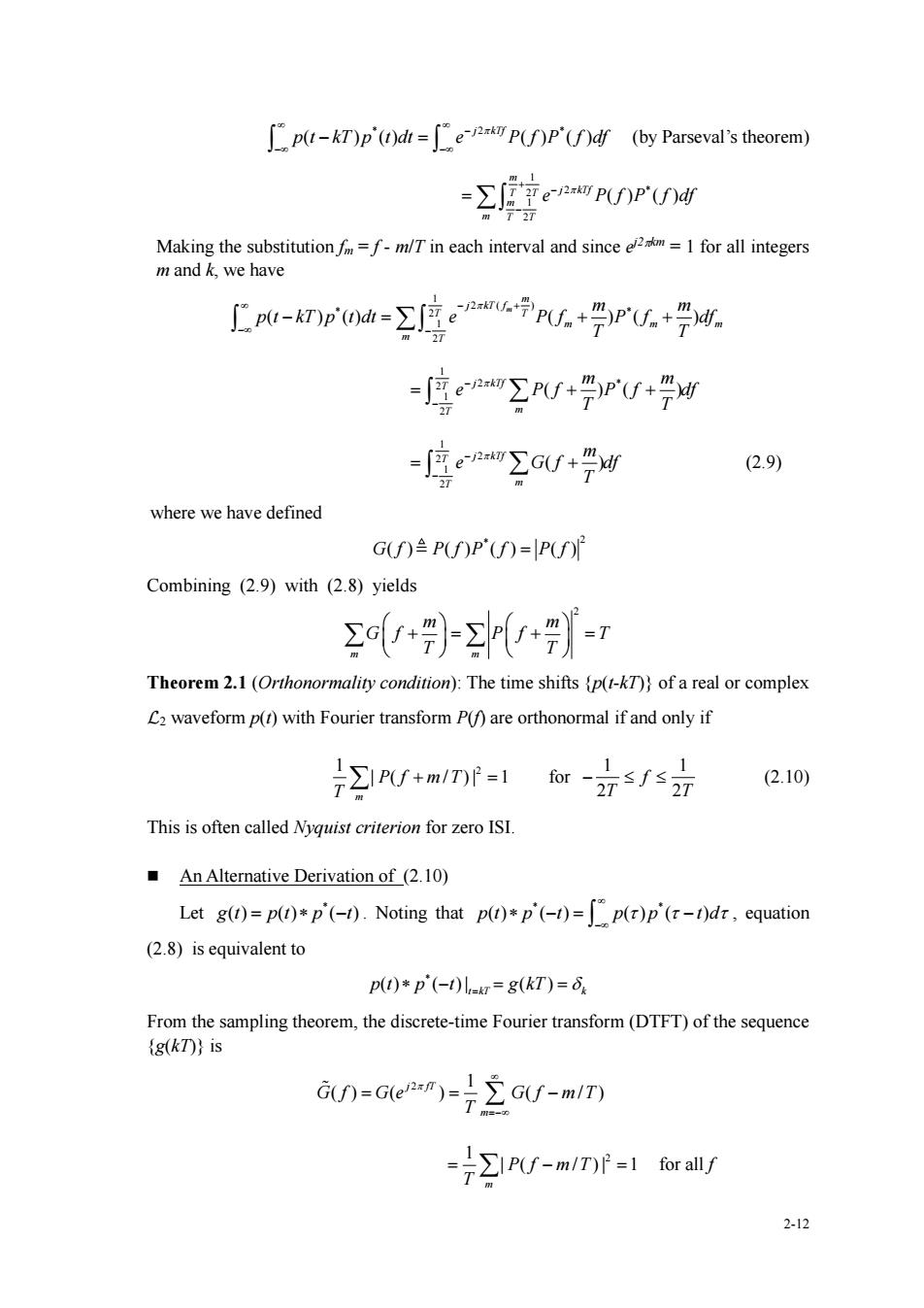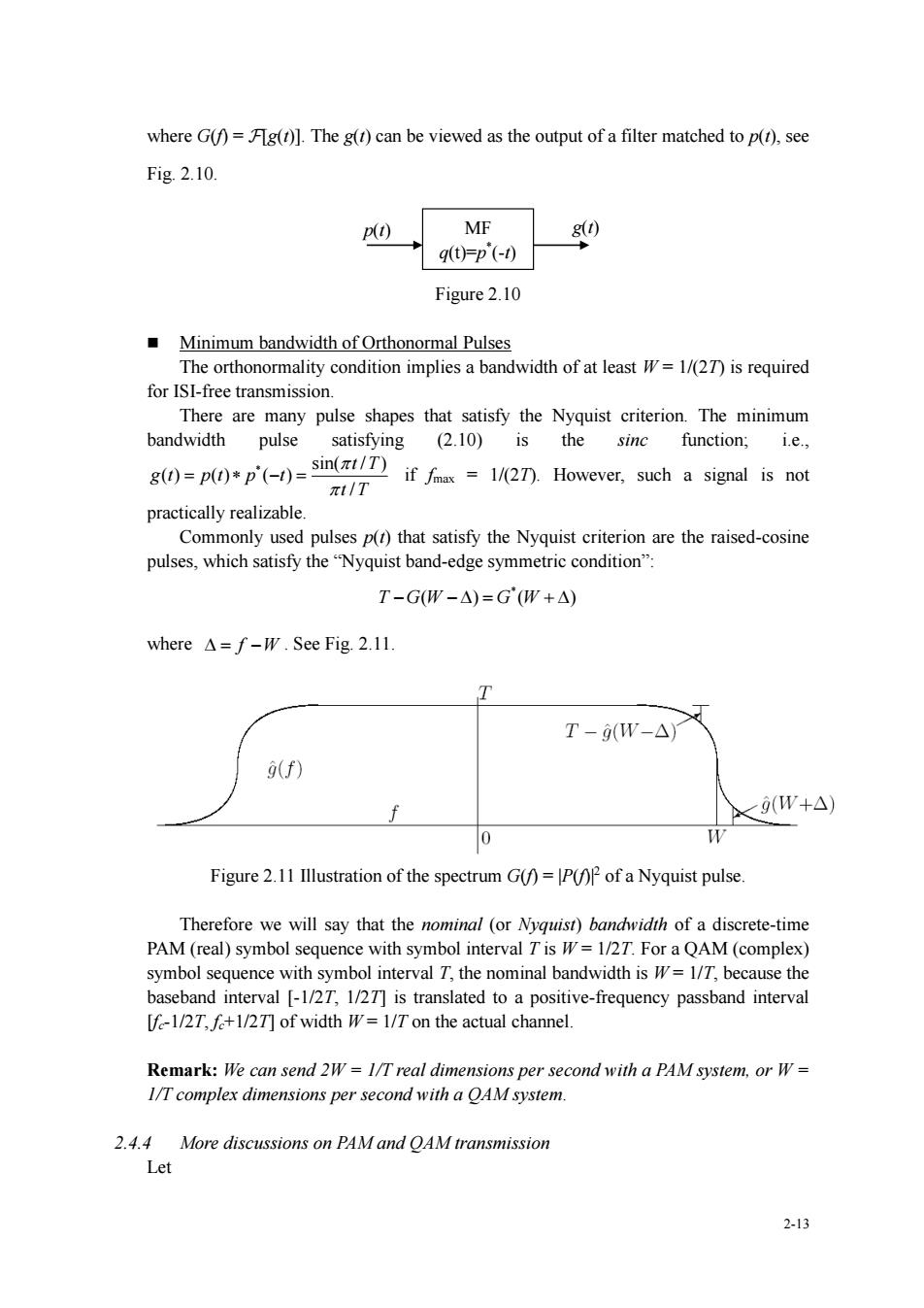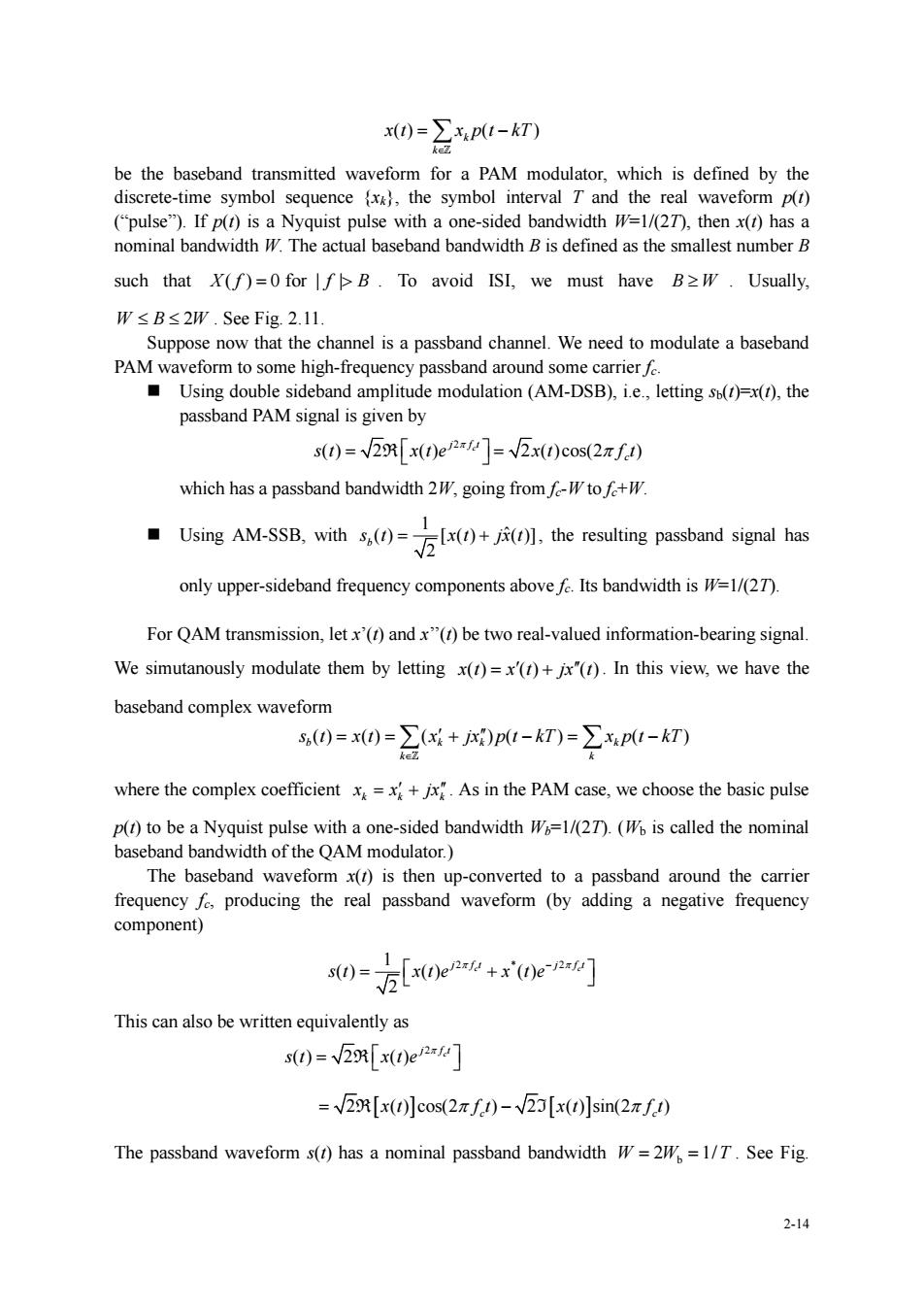
transmission over an AWGN channel and down-modulation,the received signal is 0=x(0+0 where n()is independent ofx(r)and can be represented as n)=∑n:p-kT)+广) Here is a sequence of i.i.d.zero-mean complex Gaussian variables,each with variance No,and n(r)is a Gaussian process with<n(),p(=0for all k. The output sequence of a QAM demodulator is given by y=(0),p1-kT))=x+n which represents an equivalent discrete-time AWGN channel model obtained with an orthonormal QAM system 2.4.3 Nyquist Criterion and Minimum Bandwidth 由信号检测理论可知,在AWGN下,接收滤波器采用匹配滤波器,即q)=p'(-), 能铭使得系练在采洋时别的输出信噪出达到品大,闲出匹配滤波婴(成等效地,相关 常被用作最佳接收机的前端 ,这是从抗噪声性能的角度来考虑的。从抗SI(无 失真传输)的角度来讲,我们需要选择发送滤波器p)、接收滤波器g)使得接收波形 y)=∫x(r)q(t-r)dr-∑xgt-kT) 在kT时的样值ykT)=x4 for eachk其中g)=p)*q()=∫广p(r)qt-r)dr 考虑上述两个因索,我们要求g)=p)*p'(-)满足gO)=1 and g(kT)=0for each nonzero integer k.Waveforms with this property are said to be idea Nyquist. We now consider the design of the modulation pulse p()such that the sym ol interference.(That is,find the condition under whichp( ■Nyquist Pulses In 1928,Nyquist recognized that the sinc pulse in the Sampling theorem was significant in two ways: the shifts of sinc pulse are orthogonal: the sinc pulse has the all sampling points other than at time 0 Nyquist realized that,to avoid Isl,the crucial property was to find a pulse whose shifis are orthogonal We now find the conditions under which a real waveform p(r)has the property: [1,fork=0 p(t-KT)p'(1)di= 2.8) 0,fork≠0 Note that the Fourier transform Fp(-kT)]=eP(f),we have 21
2-11 transmission over an AWGN channel and down-modulation, the received signal is y(t) = x(t) + n(t) where n(t) is independent of x(t) and can be represented as ( ) ( ) ( ) k k n t n p t kT n t ⊥ = − + Here {nk} is a sequence of i.i.d. zero-mean complex Gaussian variables, each with variance N0, and n t( ) ⊥ is a Gaussian process with < n t( ) ⊥ , p(t-kT)> = 0 for all k. The output sequence of a QAM demodulator is given by ( ), ( ) k k k y y t p t kT x n = − = + which represents an equivalent discrete-time AWGN channel model obtained with an orthonormal QAM system. 2.4.3 Nyquist Criterion and Minimum Bandwidth 由信号检测理论可知,在 AWGN 下,接收滤波器采用匹配滤波器,即 * q t p t ( ) ( ) = − , 能够使得系统在采样时刻的输出信噪比达到最大,因此匹配滤波器(或等效地,相关 器)通常被用作最佳接收机的前端。这是从抗噪声性能的角度来考虑的。从抗 ISI(无 失真传输)的角度来讲,我们需要选择发送滤波器 p(t)、接收滤波器 q(t)使得接收波形 ( ) ( ) ( ) ( ) k k y t x q t d x g t kT − = − = − 在 t=kT 时的样值 ( ) k y kT x = for each k, 其中 g t p t q t p q t d ( ) ( )* ( ) ( ) ( ) − = = − . 考虑上述两个因素,我们要求 * g t p t p t ( ) ( ) ( ) = − 满足 g(0) 1 = and g kT ( ) 0 = for each nonzero integer k. Waveforms with this property are said to be idea Nyquist. We now consider the design of the modulation pulse p(t) such that the PAM/QAM system has no intersymbol interference. (That is, find the condition under which {p(t-kT)} forms a orthonormal set.) ◼ Nyquist Pulses In 1928, Nyquist recognized that the sinc pulse in the Sampling theorem was significant in two ways: - the shifts of sinc pulse are orthogonal; - the sinc pulse has the value 0 at all sampling points other than at time 0. Nyquist realized that, to avoid ISI, the crucial property was to find a pulse whose shifts are orthogonal. We now find the conditions under which a real waveform p(t) has the property: * 1, for 0 ( ) ( ) 0, for 0 k p t kT p t dt k − = − = (2.8) Note that the Fourier transform 2 [ ( )] ( ) j kTf p t kT e P f − − = , we have

[p(t-kT)p'(t)dt=[eP()P()df (by Parseval's theorem) =∑自P Making the substitution=f-m/T in each interval and since e2m=1 for all integers m and k we have L-切pah=度enc宁pU+学PrU,+學 =∫应e∑PU+"P'U+ =度ew∑cU+学 (2.9) where we have defined G(f)P()P'(f)=P( Combining (2.9)with (2.8)yields Σ+)-Σr+=7 Theorem 2.1(Orthonormality condition):The time shifts (p(-)of a real or complex C2 waveform p(r)with Fourier transform P()are orthonormal if and only if ∑PU+mf=1sfs7 (2.10) This is often called Nyquist criterion for zero ISI. An Alternative Derivation of(2.10) Let g(t)=p(t)*p'(1).Noting that p(t)*p(t)=p(r)p'(-1)dr,equation (2.8)isequivalent to p0*p'(-)L=g(kT)=6 From the sampling theorem,the discrete-time Fourier transform(DTFT)of the sequence g(D)is an=Gea)-号cU-mm =7∑iPU-m/T)f=1 forall 2-12
2-12 * 2 * ( ) ( ) ( ) ( ) j kTf p t kT p t dt e P f P f df − − − − = (by Parseval’s theorem) 1 2 2 * 1 2 ( ) ( ) m T T j kTf m m T T e P f P f df + − − = Making the substitution fm = f - m/T in each interval and since e j2km = 1 for all integers m and k, we have 1 2 ( ) * * 2 1 2 ( ) ( ) ( ) ( ) m m j kT f T T m m m m T m m p t kT p t dt e P f P f df T T − + − − − = + + 1 2 2 * 1 2 ( ) ( ) T j kTf T m m m e P f P f df T T − − = + + 1 2 2 1 2 ( ) T j kTf T m m e G f df T − − = + (2.9) where we have defined 2 * G f P f P f P f ( ) ( ) ( ) ( ) = Combining (2.9) with (2.8) yields 2 m m m m G f P f T T T + = + = Theorem 2.1 (Orthonormality condition): The time shifts {p(t-kT)} of a real or complex 2 waveform p(t) with Fourier transform P(f) are orthonormal if and only if 1 2 | ( / ) | 1 m P f m T T + = for 1 1 2 2 f T T − (2.10) This is often called Nyquist criterion for zero ISI. ◼ An Alternative Derivation of (2.10) Let * g t p t p t ( ) ( ) ( ) = − . Noting that * * p t p t p p t d ( ) ( ) ( ) ( ) − − = − , equation (2.8) is equivalent to * ( ) ( ) | ( ) t kT k p t p t g kT = − = = From the sampling theorem, the discrete-time Fourier transform (DTFT) of the sequence {g(kT)} is 2 1 ( ) ( ) ( / ) j fT m G f G e G f m T T =− = = − 1 2 | ( / ) | 1 m P f m T T = − = for all f

where G()=Fg()].The g(r)can be viewed as the output of a filter matched to p().see Fig.2.10 p() MF 0 q(t)-p(-1) Figure 2.10 Minimum bandwidth of Orthonormal Pulses The orthonormality condition implies a bandwidth of at least W=1/(27)is required for ISI-free transmission. Ther are many pulse shapes that satisfy the Nyquist criterion.The minimum bandwidth pulse satisfying (2.10)is the sinc function;i.e., 80=p0*p(-)=sinπt/T 1/T if fiax =1/(27).However,such a signal is not practically realizable Com only used pulses p()that satisfy the Nyquist criterion are the raised-cosine pulses,which satisfy theNyquist band-edge symmetric condition" T-GW-△)=G(W+△) where A=f-W.See Fig.2.11. 2 T-g(W-△) (f) <(W+△) 公 Figure 2.11 Illustration of the spectrum G()=P()P of a Nyquist pulse. Therefore we will say that the nominal (or Nyquisr)bandwidih of a discrete-time PAM(real)symbol sequenc e with symbol i For a QAM(complex) symbol sequence with symbol interval T,the nominal bandwidth is=1/T,because the baseband interval [-1/27,1/27]is translated to a positive-frequency passband interval Uf-1/2T,fe+1/2T]of width W=1/T on the actual channel. Remark:We can send 2W=I/T real dimensions per secondwith a PAM system.or W I/T complex dimensions per second with a OAM system. 2.4.4 More discussions on PAM and OAM transmission Let 2-13
2-13 where G(f) = [g(t)]. The g(t) can be viewed as the output of a filter matched to p(t), see Fig. 2.10. Figure 2.10 ◼ Minimum bandwidth of Orthonormal Pulses The orthonormality condition implies a bandwidth of at least W = 1/(2T) is required for ISI-free transmission. There are many pulse shapes that satisfy the Nyquist criterion. The minimum bandwidth pulse satisfying (2.10) is the sinc function; i.e., * sin( / ) ( ) ( ) ( ) / t T g t p t p t t T = − = if fmax = 1/(2T). However, such a signal is not practically realizable. Commonly used pulses p(t) that satisfy the Nyquist criterion are the raised-cosine pulses, which satisfy the “Nyquist band-edge symmetric condition”: * T G W G W − − = + ( ) ( ) where = −f W . See Fig. 2.11. Figure 2.11 Illustration of the spectrum G(f) = |P(f)|2 of a Nyquist pulse. Therefore we will say that the nominal (or Nyquist) bandwidth of a discrete-time PAM (real) symbol sequence with symbol interval T is W = 1/2T. For a QAM (complex) symbol sequence with symbol interval T, the nominal bandwidth is W = 1/T, because the baseband interval [-1/2T, 1/2T] is translated to a positive-frequency passband interval [fc-1/2T, fc+1/2T] of width W = 1/T on the actual channel. Remark: We can send 2W = 1/T real dimensions per second with a PAM system, or W = 1/T complex dimensions per second with a QAM system. 2.4.4 More discussions on PAM and QAM transmission Let MF q(t)=p * (-t) p(t) g(t)

0=∑-k灯) be the baseband transmitted waveform for a PAM modulator,which is defined by the discrete-time symbol sequencex,the symbol interval T and the real waveform p() ("pulse").If p(r)is a Nyquist pulse with a one-sided bandwidth W=1/(27).then x(t)has a nominal bandwidth W.The actual baseband bandwidth B is defined as the smallest number B such that (f)=0 forfB.To avoid ISI,we must have B2W.Usually, W≤B≤2IW.See Fig.2.1l Suppose now that the channel is a passband channel.We need to modulate a baseband PAM waveform to some high-frequency passband around some carrier fe. Using double sideband amplitude modulation (AM-DSB).ie letting s()=x(t).the passband PAM signal is given by s()=[x(D)e]x()cos(2zf) which has a passband bandwidth 2W,going from fW to f+W. Using AM-SSB,with s,(r)= the resulting passband signal has 1 only upper-sideband frequency components abovef.Its bandwidth is W=1/(27). For QAM transmission,let x'(r)and x"(t)be two real-valued information-bearing signal. We simutanously modulate them by letting x()=x()+x().In this view,we have the baseband complex waveform s()=x()=∑(x+jx)p1-kT)=∑xp1-kT) where the complex coefficient+x As in the PAM case,we choose the basic pulse ()to be a Nyquist pulse with a one-sided bandwidth W1/(2T).is called the nominal baseband bandwidth of the QAM modulator.) The baseband waveform x(r)is then up-converted to a passband around the carrier frequency f producing the real passband waveform (by adding a negative frequency component) This can also be written equivalently as s()=x()e =V2R[x]cos(2πf)-V2[x]sin(2πf) The passband waveform s(t)has a nominal passband bandwidth W=2W=1/T.See Fig. 2-14
2-14 ( ) ( ) k k x t x p t kT = − be the baseband transmitted waveform for a PAM modulator, which is defined by the discrete-time symbol sequence {xk}, the symbol interval T and the real waveform p(t) (“pulse”). If p(t) is a Nyquist pulse with a one-sided bandwidth W=1/(2T), then x(t) has a nominal bandwidth W. The actual baseband bandwidth B is defined as the smallest number B such that X f f B ( ) 0 for | | = . To avoid ISI, we must have B W . Usually, W B W 2 . See Fig. 2.11. Suppose now that the channel is a passband channel. We need to modulate a baseband PAM waveform to some high-frequency passband around some carrier fc. ◼ Using double sideband amplitude modulation (AM-DSB), i.e., letting sb(t)=x(t), the passband PAM signal is given by 2 ( ) 2 ( ) 2 ( )cos(2 ) c j f t c s t x t e x t f t = = R which has a passband bandwidth 2W, going from fc-W to fc+W. ◼ Using AM-SSB, with 1 ( ) [ ( ) ( )] ˆ 2 b s t x t jx t = + , the resulting passband signal has only upper-sideband frequency components above fc. Its bandwidth is W=1/(2T). For QAM transmission, let x’(t) and x’’(t) be two real-valued information-bearing signal. We simutanously modulate them by letting x t x t jx t ( ) ( ) ( ) = + . In this view, we have the baseband complex waveform ( ) ( ) ( ) ( ) ( ) b k k k k k s t x t x jx p t kT x p t kT = = + − = − where the complex coefficient k k k x x jx = + . As in the PAM case, we choose the basic pulse p(t) to be a Nyquist pulse with a one-sided bandwidth Wb=1/(2T). (Wb is called the nominal baseband bandwidth of the QAM modulator.) The baseband waveform x(t) is then up-converted to a passband around the carrier frequency fc, producing the real passband waveform (by adding a negative frequency component) 1 2 2 * ( ) ( ) ( ) 2 c c j f t j f t s t x t e x t e − = + This can also be written equivalently as 2 ( ) 2 ( ) c j f t s t x t e = R = − 2 ( ) cos(2 ) 2 ( ) sin(2 ) R I x t f t x t f t c c The passband waveform s(t) has a nominal passband bandwidth b W W T = = 2 1/ . See Fig

2.12. -W。0W。=1/2T su) 0 Figure 2.12 Thus.when talking about PAM.we defined the nominal bandwidth =1/(27) where T is the s communication, mbol interval.On the other hand,with QAM and passband Summary [Degrees of freedom] With PAM,we could choose real symbols separated by T and transmit them in a bandwidth W=1/(27).Thus,over a long interval To,we can transmit To/T=2WTo real symbols. Using QAM,with symbols separated bywe need a passband bandwidth/ However,each symbol is complex,and the real and imaginary parts can be selected independently.Thus,again,over a long interval To,we can transmit 2WTo real symbols. Therefore,in principle,QAM and baseband PAM with the same overall bandwidth trant reasymo of the number of degrees of freedom that can be used to are equiva 2.5 Orthogonal (Multipulse)Modulation and Generalized Nyquist Criterion In baseband PAM.a single pulse shape p(r)is used in one symbol interval,and amplitude modulated by the daa symbolWe this model by the pulse shape in any symbol interval to be chosen from a set of N possibilities, p().0nN-),to represent logN bits of information.The transmitted signal can then be written as x)=∑P,-kT) where x[0,N-1].The data symbol thus indexes which pulse is transmitted in the kth symbol interval,rather than the amplitude of the pulse that is transmitted.If thep (isa set of orthogonal pulses,i.e. 2-15
2-15 2.12. S(f) -fc 0 fc W=1/T 0 X(f) b −Wb W T = 1/ 2 Figure 2.12 ◼ Thus, when talking about PAM, we defined the nominal bandwidth W=1/(2T), where T is the symbol interval. On the other hand, with QAM and passband communication, W=1/T. ◼ Summary [Degrees of freedom]: With PAM, we could choose real symbols separated by T and transmit them in a bandwidth W=1/(2T). Thus, over a long interval T0, we can transmit T0/T = 2WT0 real symbols. Using QAM, with symbols separated by T we need a passband bandwidth W=1/T. However, each symbol is complex, and the real and imaginary parts can be selected independently. Thus, again, over a long interval T0, we can transmit 2WT0 real symbols. Therefore, in principle, QAM and baseband PAM with the same overall bandwidth are equivalent in terms of the number of degrees of freedom that can be used to transmit real symbols. 2.5 Orthogonal (Multipulse) Modulation and Generalized Nyquist Criterion In baseband PAM, a single pulse shape p(t) is used in one symbol interval, and amplitude modulated by the data symbol xk. We can generalize this model by allowing the pulse shape in any symbol interval to be chosen from a set of N possibilities, { ( ),0 1} n p t n N − , to represent log2N bits of information. The transmitted signal can then be written as ( ) ( ) k x k x t p t kT = − where xk[0, N-1]. The data symbol thus indexes which pulse is transmitted in the kth symbol interval, rather than the amplitude of the pulse that is transmitted. If the { ( )} n p t is a set of orthogonal pulses, i.e